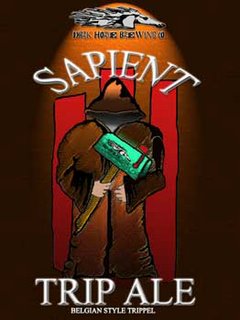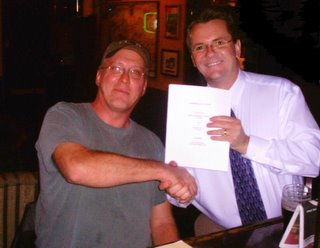Tuesday, January 31, 2006
A brief history of Gravity Head, 1999-2006.
Gravity Head has evolved in strange and incredible ways since its humble and improvisational beginnings in 1999. With the eighth such celebration now visible on the horizon, here's a glance at past Gravity Heads.
----
Gravity Head Version 1.0 … April 29, 1999.
The Gravity Head concept dates to 1999, when we decided to inaugurate our newly completed walk-in beer cooler by featuring as many “hoppy” beers as could be located on short notice. The ensuing festival would be called “Hop Head.”
Subsequently, more “gravity” beers were available than “hoppy” ones, and the festival accordingly morphed into Gravity Head.
According to our flier, the inaugural Gravity Head would last “until each keg has passed away into memory’s warm glow of the greatest draft beer line-up ever seen in the metropolitan Louisville area.” Many of these beers, including Delirium Tremens and Bell’s Two Hearted Ale, have since become standards in the Rich O’s draft lineup.
“We’ve just signed legislation outlawing light beer forever … the bombing begins on March 31, 2000.”
In 2000, we upped the ante by offering six barley wines simultaneously … along with five Belgian strong specialty ales, four German bocks, three English strong ales, three imperial stouts, and two other American ales for good measure. It was the first year for t-shirts (featuring the phrase above and a catapult), “The Gravity Form,” the enshrinement of the starting lineup announcement and running the gauntlet as rites of Gravity passage.
March 9, 2001: “Light beer? I’m sorry, sir, but you’re cut off.”
The local debuts of draft Samichlaus, Eggenberg Urbock 23, Hair of the Dog’s Fred and Adam, Scotch de Silly and Gale’s Millennium Brew, but more importantly, three cask-conditioned gravity ales were dispensed during the first three weekends of the festival.
Gravity Head 2002, beginning March 8, 2002: “Liteweights need not apply.”
The emphasis in 2002 was placed on microbrewed gravity beers: Three powerhouse ales from Rogue in Oregon, three from Kalamazoo (Bell’s) Brewing in Michigan, two from Victory Brewing (“Malt Advocate” magazine’s Brewery of the Year) in Pennsylvania, and one from Brooklyn Brewing in New York. There were three cask-conditioned ales in 2002, and altogether, 16 first-time draft beers, including some that were making their Kentuckiana debuts.
Gravity Head 2003, beginning March 7, 2003: “Guilty as charged, Liteweight.”
18 first-time drafts led the way, including Bell’s Expedition Stout and our own NABC Solidarity. We bid a fond farewell the 1996 vintage of Rogue Old Crustacean Barley Wine - Crusty, we hardly knew ye!
Gravity Head 2004, beginning March 12: “Raise Your Glass to the Gravity Head Diet.”
Thanks to the experimental use of a cold plate, it was possible to have 18 gravity beers on tap at once. Also, once again, 18 first-time “Gravity Head Friendly” contestants were recorded. The recent trend of emphasizing microbrewed gravity beers continued, as it was becoming progressively easier to obtain the best in American brewing.
Gravity Head 2005, beginning March 11: “It’s a Whole New Dementia.”
The seventh edition of Gravity Head will be remembered for the Publican’s questionable decision to contract pneumonia and be absent for much of the first two weeks. A diverse selection of gravity textures and flavors included 15 first-time drafts, with NABC’s own NobleSmoker moving fastest.
See "End of January update: "Gravity Head 2006: Reality ABV" advance orders preview" for the latest on this year's edition.
Monday, January 30, 2006
Browning's Restaurant and Brewery is progressing.
 Brewmaster Brian Reymiller of Browning’s Restaurant and Brewery dropped by Rich O's last week for a chat and a pint, accompanied by an out-of-town friend, Ed, who Brian said gave him his first brewing job (at a Hops! Brewery franchise somewhere Down South).
Brewmaster Brian Reymiller of Browning’s Restaurant and Brewery dropped by Rich O's last week for a chat and a pint, accompanied by an out-of-town friend, Ed, who Brian said gave him his first brewing job (at a Hops! Brewery franchise somewhere Down South).
Later Brian worked for Victory Brewing in Pennsylvania, a curmudgeonly favorite, and Smoky Mountain Brewing Company in Tennessee. He came to Browning’s during a period of reorganization (to put it diplomatically), and although there’s still work to be done to permanently establish Browning’s as an upper echelon option for Louisville-area beer enthusiasts, it would seem that much progress is being made.
Browning’s (slightly upscale pub ambience) and the adjoining Park Place on Main (white tablecloth) are situated in Louisville Slugger Field, home of the AAA Bats.
The chef is local legend Anoosh Shariat, a man whose considerable talents are perhaps more applicable to the Park Place side, but who has lifted the quality and flair of the brewpub menu beyond where it was before his arrival.
As noted at the brewpub’s half of the joint web site, the list of regular beer offerings has been tightened to four principles and given proper names, mostly derived from Louisville history: Saint Hildegard Helles Lager, John Shield’s Blacksmith Porter, Fleur De Lis IPA and Louis XVI Guillotine ESB.
The physical set-up of the brewpub remains stunning, with a two-story glass enclosed brewing tower looking out over the seating area. There have been problems in the past with balancing the cathedral-like height of the ceilings with the need to suggest warmth and intimacy on the floor, but in spite of ongoing efforts to bring this about by rearranging furniture and booths, probably the best solution is to have the brewpub filled with people drinking beer, dining and having fun.
Readers are encouraged to check out Brian’s brewing work and report on the experience at Browning’s.
(Photo credit goes to the Browning's web site ... by chance, was it assembled by New Albany's Idealogy band of merry ad men?)
Sunday, January 29, 2006
Courier-Journal notes “passing of the fork” as restaurant critic Susan Reigler moves to travel writing.
It’s time to shuffle the deck in Gannettland.
The changing dining scene; Unveiled critic recalls expansion, by Susan Reigler, Courier-Journal critic.
My byline will be moving to Sundays, where I'll soon have a new beat as The Courier-Journal's travel writer in an expanded, stand-alone Travel section that has its premiere Feb. 12.
Instead of bon appetit, I will be wishing you bon voyage!
It certainly doesn’t sound like a demotion, does it?
But overall, it’s a Cal Ripkin sort of moment.
Susan’s done 662 C-J dining columns since May, 1992; eerily, I began my labors at Rich O’s Public House a month or so later. If memory serves, her first review of our place was in 1995 (it was positive for the most part, and we eventually replaced the ratty carpet, anyway).
It’s true that over the years, Susan came to be a regular weekly visitor to Rich O’s owing to another of her many sidelines, music, and I’m proud to say that we’ve served her a pint or two of fine ale along the way.
As for the other side of the coin, I’ve tended to sidestep criticisms of the critic, who has caught her fair share of flak -- served piping hot by some area foodies and a few others who feel a lingering and perfectly understandable contempt for the mass-market journalistic practices of Gannett.
It’s a discussion that I won’t join, because restaurant criticism’s not my line – beer is, and as such, what I’m most thankful to Susan for undertaking over the years is the inclusion in her reviews of information about beer, where once only wine selections were noted.
For almost 14 years, Susan’s taken an interest in the beer list as well as the wine list, and although there hasn’t always been sufficient space to explore the topic in depth, she’s been willing to ask the question: Why great food with purely pedestrian beer?
Eventually Susan pioneered the C-J’s “Drinks” column, and often featured Louisville area breweries. She’s done much to help raise awareness of beer in the metro Louisville area – and that’s worth four stars to me.
There’ll be a reorganization of the newspaper’s food and drink department, with food and cooking guru Sarah Fritschner in charge and Ron Mikulak right behind her, and with freelance critical assistance from Marty Rosen, the IUS librarian and my choice for best pure writer of anyone in the area.
Let's hope that the C-J gives Marty the words he needs to shine. When you're as good as he is, 350's a travesty.
And remember -- if Susan needs help with the beer travel itinerary, I’m only a phone call away.
Saturday, January 28, 2006
End of January update: "Gravity Head 2006: Reality ABV" advance orders preview.

AS OF FEBRUARY 10, THE NEW PAGE FOR GRAVITY HEAD 2006 UPDATES AND LISTINGS IS HERE.
This page will not be updated again.
----
February 10 note: I have learned that the regular keg of JW Lees Vintage Harvest Ale (non-wood aged) was not shipped from the UK. It is scratched.
February 8 note: An Ohio contingent of one beer from Rocky River Brewing Company (Cleveland) and two from Ringnech Brewing (Strongsville) joins the unexpected arrival of Great Divide's Old Ruffian to lift microbrew orders to 30, and a grand total of 51 gravity kegs to begin flowing on February 24.
February 2 note: With the addition yesterday of Rogue's Skull Splitter, microbrew gravity orders are up to 26, with import orders at 21, for a total of 47 -- yikes! Roughly two-thirds are in stock already, with the most of the remainder due by February 14.
Here's an updated list of advance orders for Gravity Head 2006, as of February 8, 2006 .
Please note that owing to special circumstances, Gravity Head 2006 has been moved forward two weeks, and will begin on Friday, February 24.
We believe this change will occur this year only, and in 2007, the festival will revert to its usual starting position during the second weekend in March.
Or perhaps not.
As the weeks pass, this list will be augmented with further information. Remember that foraging proceeds apace, and there will be numerous changes to the roster between now and opening day.
Read: Contact me about group seating possibilities for Gravity Head opening night.
A brief history of Gravity Head, 1999-2006.
* indicates that the beer already is in stock at Rich O's.
MICROBREWED GRAVITY.
Avery "The Beast", 14.9% abv
Avery "The Reverend", 10% abv
*Bell’s Batch 7000, 12% abv
Browning's Brewery Imperial Stout, circa 9% abv (firkin)
Dark Horse Double Crooked Tree IPA, 13.6% abv
*Dark Horse Sapient Trip, 8.6% abv
*Flying Dog Gonzo Imperial Porter, 9.5% abv
*Flying Dog Horn Dog Barley Wine, 10.5% abv
Founders Blushing Monk Belgian Razz, 9.5% abv
*Founders Devil Dancer Triple IPA, (2004) 13% abv
*Founders Dirty Bastard, 8.3% abv
*Great Divide Hibernation Ale, 8.1% abv
*Great Divide Hercules Double IPA, 9.1% abv
*Great Divide Yeti Imperial Stout, 9.5% abv
*Great Divide Oak Aged Yeti Imperial Stout, 9.5% abv
Great Divide Old Ruffian Barley Wine, 10.2% abv
*NABC Stumble Bus, (2005) circa 10% abv
*NABC Thunderfoot Imperial Stout, 10% abv
*New Holland Dragon’s Milk, 10.5% abv
*North Coast PranQster, 7.6% abv
Ringneck Brewing Company "To be announced" (waiting for details)
Ringneck Oak Aged “FOTB” Barley Wine, circa 11% abv
Rocky River Neptune's Nemesis, 8% abv
Rogue (John's Locker Stock) Skull Splitter, 8.5% abv
*Rogue XS Old Crustacean Barley Wine, (2002) 11.5% abv
*Rogue XS Imperial Stout, 11% abv
*Rogue XS I2PA, 9.5% abv
*Stone Double Bastard Ale, 10% abv
*Stone Old Guardian Barley Wine, (2005) 11.26% abv
*Two Brothers Bare Tree Weiss Wine, 10.2% abv
----
IMPORTED GRAVITY.
AUSTRIA
*Samichlaus Bier (2001) 14% abv
BELGIUM
De Ranke Guldenberg, 8.5% abv
Gouden Carolus Classic, 8.5% abv
Gouden Carolus Tripel, 9% abv
*La Rulles Cuvee “Best Wishes”, 7.3% abv (moved from Saturnalia MMV)
*'t Smisje Dubbel, 9% abv
*'t Smisje Kerst, 11% abv
*Urthel Hop-It Belgian IPA, 9.5% abv
Urthel Samaranth Quadrium, 11.5% abv
CANADA
*Unibroue Maudite, 8% abv
EKU 28, 11% abv
Kulmbacher Reichelbrau Eisbock, 9.2% abv
*Weihenstephaner Korbinian Doppelbock, 7.4% abv
NETHERLANDS
Christoffel Winter Bock, 7.2% abv
UNITED KINGDOM
*Gale’s Christmas Ale, (2005) (cask-conditioned firkin)
*Gale’s Prize Old Ale (2004), 9% abv (vintage TBA)
JW Lees Moonraker, 7.5% abv (moved from Saturnalia MMV)
*JW Lees Vintage Harvest Ale, (Willoughbys crusted port barrel aged; 2004; firkin), 11.5% abv
JW Lees Vintage Harvest Ale, (Lagavulin Scotch barrel aged; 2005; pin), 11.5% abv
*Old Engine Oil Special Reserve, (Invergordon Scotch barrel aged; 2005), 8.5% abv (firkin)
----
MOVED TO DUTY DURING SATURNALIA MMVI.
*Kiuchi Hitachino Nest New Year’s Celebration Ale 2006, 9% abv
----
SCRATCHED.
Arcadia Hopmouth Imperial IPA ... was not shipped as originally promised.
Chouffe La Gnomette ... shipping schedule delayed; ETA uncertain.
De Dolle Dulle Teve (Mad Bitch) ... to be shipped after Gravity Head.
JW Lees Vintage Harvest Ale ... non-wood aged; was not shipped from the UK.
Friday, January 27, 2006
NABC's Thunderfoot Imperial Stout to be released for Gravity Head 2006.
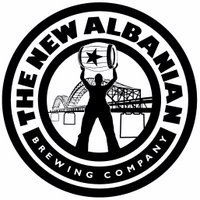 In yesterday's Publicanista! blogletter, I mentioned Thunderfoot Imperial Stout, a creation of NABC brewers Jesse Williams and Jared Williamson that will be released for Gravity Head on Friday, February 24.
In yesterday's Publicanista! blogletter, I mentioned Thunderfoot Imperial Stout, a creation of NABC brewers Jesse Williams and Jared Williamson that will be released for Gravity Head on Friday, February 24.
There'll be some top-quality Imperial Stouts on board for this year's Gravity Head, among them Bell's Batch 7000 (12% abv), Great Divide Oaked Yeti Imperial Stout (9.5% abv), and Rogue XS Imperial Stout (11% abv).
Furthermore, I was excited to learn yesterday that brewmaster Brian Reymiller of Browning's Brewery in Louisville is cask-conditioning an Imperial Stout (circa 9% abv) for Gravity Head.
You may recall the single varietal East Kent Goldings ESB that he provided for last autumn's Lupulin Land Harvest Hop fest; it was a very faithfully tended cask ale, which bodes well for an Imperial Stout similarly rendered.
In late December, Jesse and Jared squeezed in the aforementioned batch of Thunderfoot Imperial Stout (circa 10% to 12% abv). Here are some specifics.
Malts: 75% Simpson's Golden Promise 2-row; 10% roasted barley; 5% dark crystal malt; 7% sugar and 3% oats.
Hops: Northern Brewer in the boil, the Northern Brewer, Willamette and Cascade (four further additions).
Yeast: The house London ale yeast.
Intriguingly, dried tart cherries were added to the hopback, and dried Bing cherries (and oak chips) put into the Brite tanks.
It's yet to be seen what the cherries will do for the finished stout, which has matured startlingly from week to week since being brewed, but Thunderfoot is rounding into something very promising, and it should be a worthy match for the other Imperial Stouts booked for Gravity Head.
And as you may know, the Curmudgeon just adores Imperial Stout.
End of January update: "Gravity Head 2006: Reality ABV" advance orders preview.
Thursday, January 26, 2006
Greetings from Michigan -- the Great Lakes State.*
* with apologies to Sufjan Stevens, a Detroit native with Holland connections.
Michigan will have strong representation at Gravity Head 2006, and the reason for this is simple.
There are great breweries and equally fine beer in abundance in Michigan.
Perhaps the most interesting of them all is the fabulously funky Jolly Pumpkin, which describes itself as a "land of open fermentation, oak barrel aging, and bottle conditioning."
Alas, no kegs (that's not what they do), and so no Gravity Head, but we're trying to keep bottles in stock; check the last Publicanista! blogletter for availability.
Kalamazoo Brewing Company is a known entity of long standing, and over the years, we've probably served two dozen different Bell's beers on tap throughout the year. Dark Horse (Marshall), Founders (Grand Rapids), and New Holland (Holland) haven't been around quite as long, but each has an outstanding reputation for microbrewing quality and innovation.
Of the four, I know the least about Dark Horse, but fortunately there's an excellent story in the Battle Creek Enquirer from 2005.
Sapient Trip will be on site next week; Double Crooked Tree will come along later in February. Both will be held for Gravity Head duty. For those keeping score, the Dark Horse Tres Blueberry Stout promised for Saturnalia finally arrived, and probably will be on tap by Saturday, January 28.
Here are the Michigan beers slated for Gravity Head 2006:
*Bell’s Batch 7000 12% abv
Dark Horse Double Crooked Tree IPA 13.6% abv
Dark Horse Sapient Trip 8.6% abv
Founders Blushing Monk Belgian Razz 9.5% abv
Founders Devil Dancer Triple IPA (2004) 13% abv
Founders Dirty Bastard 8.3% abv
*New Holland Dragon’s Milk 10.5% abv
See also: End of January update: "Gravity Head 2006: Reality ABV" advance orders preview.
Wednesday, January 25, 2006
This just in: Gouden Carolus and Gouden Carolus Tripel for Gravity Head.
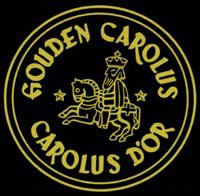 I've just confirmed that we'll be able to purchase a keg each of Gouden Carolus and Gouden Carolus Tripel, which are brewed by Anker in Belgium and imported by Wetten International.
I've just confirmed that we'll be able to purchase a keg each of Gouden Carolus and Gouden Carolus Tripel, which are brewed by Anker in Belgium and imported by Wetten International.
These are classic examples of Belgian ale, and ones that have gotten even better in recent years owing to foresight and commitment on the part of the brewery's brain trust.
To compete in a tight market, they've resisted the temptation to cut corners, instead choosing to invest in their brew kit and to emphasize the "Belgianness" of their beers, going so far as to establish a policy of using only Belgian hops from the district around Poperinge.
There'll be more tomorrow on the still evolving Gravity Head lineup.
See also: End of January update: "Gravity Head 2006: Reality ABV" advance orders preview.
Tuesday, January 24, 2006
Niagara Falls, frozen beer and Dave Thrasher's panorama.
 Downtown New Albany art store owner Dave Thrasher is a visionary.
Downtown New Albany art store owner Dave Thrasher is a visionary.He sees art as the vanguard of renewal, and if given free rein, would transform sidewalks and street corners into an open-air urban sculpture park.
Dave also is mobile, accepting work where he finds it, so oftentimes he’s on the road earning a paycheck. Lately he’s been in Ontario, on the Canadian side of Niagara Falls, and when he returned home for a weekend visit and dropped by Rich O’s to drain some grain, Dave came bearing a gift.
It’s a 750 ml bottle of Niagara Falls Brewing Company Eisbock, which lays claim to being the first North American brewery to brew and sell beer that has been frozen and its alcohol content concentrated by removing the ice – which freezes first.
It’s an old German trick, still seen today in the Kulmbacher Reichelsbrau Eisbock G’frorns (drink it at Gravity Head 2006).
To me, the most interesting thing about the notion of freezing beer or wine is that prior to the invention of distillation (by Arabs looking to extract essences for the production of perfume), it was the only way to defy the natural limits of fermentation and concentrate the alcohol content. Fermentation occurs in nature, but distillation is a man-made, industrial process.
Removing the ice does more than concentrate the alcohol. It deepens flavors and sometimes does wild things with esters, as in the case of Aventinus Eisbock (from Germany’s Schneider wheat beer brewery), a delicious take on a wheat-based Doppelbock that emerges from freezing with a flavor almost akin to bubble gum, but in a very good way.
Overall, Niagara Falls Eisbock is tame by comparison with its German forebearers, but highly enjoyable just the same. The alcohol content is 8% by volume, a shade higher than conventional Doppelbock, with which it shares characteristics of color brownish copper and malty flavor – perhaps toffee meets Fig Newton, and certainly interesting and with complex, fruity strains that make me curious as to whether this is a top- or bottom-fermented beer, or whether the freezing is entirely the cause.
Either way, it certainly kept me company for a long while on a cool, though far from chilly evening in bizarrely balmy New Albany.
Somewhere in Canada, Dave Thrasher certainly is better placed climactically to enjoy the warming attractions of Eisbock, and I hope he is. Here’s to a great future for New Albany, Dave’s sculpture idea, and our joint project of painting the exterior concrete walls at the senior citizen’s high rise.
Monday, January 23, 2006
Differentiation: Which -- and how -- do you choose?
 A day in the life …
A day in the life …
I’m handed a bottle of beer called Thirsty Dog Hoppus Maximus, and the representative of the same wholesale distributorship that recently went a month without having draft Sierra Nevada Pale Ale mispronounces the name before pushing forward the same company’s Old Leghumper and giggling at the image of leggy broads with – what else – a dog.
Ominous, indeed.
Hoppus Maximus bears an alarmingly cheesy label of a Roman legionnaire wannabe with – what else – dogs, set against a backdrop of a Great American Beer Festival medal, and for good reason. HM has medalled four times since 2001.
The beer pours clear and clean, great lace … and a tinge of orange, perhaps the tiniest hint of amber, in the color. It smells like an American Pale Ale, tastes like an American Pale Ale, and is referred to as Pale Ale on the beer rating sites.
So much for unanimity, because all of its medals have come in the GABF’s Amber/Red category. Go figure … and if the answer comes to you, let me know.
It is a clean beer. Bittering hops are largely absent, but there’s plenty of piney citrus in the finishing hops. The body is very light, almost to the point of non-existent. The alcohol content is 5%. In every respect, HM is so technically adept that it might have been an Anheuser-Busch mockrobrew.
For the record, the Thirsty Dog line of beers originated in Ohio, and is contract brewed at Frederick Brewing Company (Maryland).
Conclusions? Perhaps a rant, first.
As both publican and as beer drinker in private life, my taste buds operate under a principle of differentiation.
What about this beer is different? How does it differ from others in the style category? Is it sufficiently special to merit extra effort to find it, or is it the sort of beer you’d be perfectly happy to drink at the brewery’s taproom or pub, but wouldn’t seek it out otherwise?
Labels, graphics and extraneous enticements are not sufficient to achieve differentiation, at least for me, and the consumption context isn’t, either.
The cream of the microbrewed crop combine marketing, art and product originality (think Stone, Three Floyds and the like), and the beer’s still good even after you’ve poured it into a glass and tossed the bottle in the recycling bin.
As for consumption context, I mean that the beer’s still good even if you’re not drinking it in the company of a hot date, at the brewery tap or while watching your team win a playoff game. So often we mistakenly associate beer quality with other enjoyable external factors.
I understand that I’m swimming against the tide. Graphics move products off crowded store shelves, and clever ad campaigns showing a sunny beach and a bottle of insipid Corona do, too. However, that’s what curmudgeons do. We're contrarian.
It's in our blood.
Granted, there is a cool zone of hostility in my heart for breweries that come up with great names, and proceed to wrap them around ordinary beers, and quite frankly, it’s hard to be objective when there’s nothing Hoppus Maximus about Thirsty Frederick Dog’s beer other than GABF medals for the Zelig of microbrewed style categories.
Call me funny, but shouldn’t amber and red ales be (a) amber and red, and (b) have definable malt character?
Apart from all that, Hoppus Maximus is technically flawless ale set squarely in the middle of the road. Calibrate price points, and make your decisions accordingly.
And Old Leghumper?
Promises less, achieves more; center of the style target, deep brown cousin of stout, perhaps a bit more to the malty sweet side than I prefer, but certainly in the range of microbrewed porters everywhere … and, alas, providing the keeper of the beer list with no real flag of differentiation, and consequently no recommendation to stock it.
Neither of these samples are bad beers. Not at all.
But sometimes it’s worth remembering that the little imperfections are what make beers memorable.
Sunday, January 22, 2006
More on the advent of Bistro New Albany.
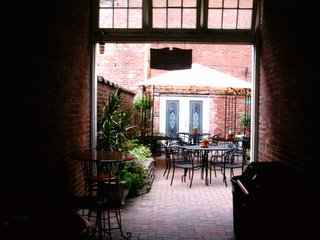 Yesterday’s posting was a reprint of an NA Confidential article from earlier in the week that predicted a January 30 opening for the new Bistro New Albany.
Yesterday’s posting was a reprint of an NA Confidential article from earlier in the week that predicted a January 30 opening for the new Bistro New Albany.
As you may know, this venture does not represent direct financial investment on my part, and is not an offshoot of NABC in any way.
However, BNA will be serving New Albanian Brewing Company beers (and Bluegrass Brewing's, as well as a variety of guest drafts), and as such, it has been regarded since its inception as NABC's downtown taproom of sorts.
My keen interest in Greg’s and Dave’s business goes far beyond the relatively minimal profit that NABC can be expected to garner from beer sales, although money and exposure of course are important.
Since taking up residence in downtown New Albany in 2003, it has been my goal to do whatever I can to contribute to its revitalization.
It is my firm belief that owing to a number of fortuitous factors, many like-minded people have come together over the past two years to bolster the ranks of those who never flagged in their efforts to improve New Albany’s historical core, but simply needed reinforcements and encouragement to take the struggle to the next level.
Accordingly, the advent of Bistro New Albany is a powerful statement of confidence in the future of downtown New Albany.
As long-term veterans of the restaurant business, Greg and Dave spent quite some time investigating start-up possibilities throughout the metropolitan Louisville area … and they chose a venue that some might regard as counter-intuitive or even perverse, although I prefer to think that posterity will recognize that the hopeful signs were simply too many to ignore.
Speaking both personally and on behalf of NABC, it’s going to be very exciting to pair our craft beers with the creative menu items that will be offered at Bistro New Albany.
Rest assured, I already know which beer goes best with our pizza and sandwiches, but the thought of exploring the flavor combinations with a buffalo burger, fresh daily pasta and Capriole goat cheese (among others) stimulates the imagination.
In addition, a local attorney recently told me that the absence of an off-premise “meeting place” downtown hampers productivity. I think you’ll see BNA become such a place. It shouldn't be forgotten that Denver's Wynkoop Brewing Company was the primary early impetus for the revitalization of Lower Downtown (LoDo).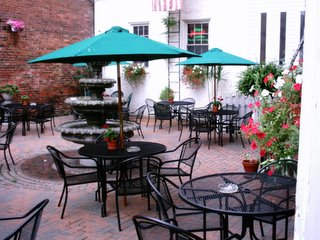
I’ve been asked many times what BNA plans to do for Sunday hours, and as I understand it, nothing is being planned – at least in the beginning.
Greg and Dave have discussed doing a Sunday brunch, but over and above that, let’s hope that it becomes possible during the warm weather months to have the outdoor patio and garden area open for business.
There’s something about drinking good beer outside in nice weather, and something more to drinking it in a lovely setting like the BNA’s garden, especially on a on-working Sunday at the conclusion of a vigorous walk or bicycle ride.
When I pause to consider the other quality-of-life improvements coming to New Albany – Phase I of the Ohio River Greenway, the imminent likelihood of opening the K & I Bridge to link to Louisville’s River Walk, Scribner Place construction, the early stages of loft and condo conversions downtown --- hopeful scenarios are many and bright.
BNA stands to be a huge part of it all. Wish them luck, and check them out when the opportunity arises.
See also “A walk would do you good, Steve.”
Saturday, January 21, 2006
Bistro New Albany looking firm for a January 30 opening.
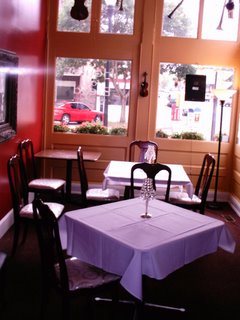 A visit earlier this week confirmed that our friends and intrepid downtown New Albany bistro pioneers, Greg Merz and Dave Clancy, remain knee deep in the all-from-scratch hoopla that attends opening a restaurant, and although they were intent on a January 23 opening, it looks as though January 30 will be the probable starting date.
A visit earlier this week confirmed that our friends and intrepid downtown New Albany bistro pioneers, Greg Merz and Dave Clancy, remain knee deep in the all-from-scratch hoopla that attends opening a restaurant, and although they were intent on a January 23 opening, it looks as though January 30 will be the probable starting date.
Hiring is under way, dry goods are coming in, and the various regulatory stipulations are being met.
Although the dining area in the former House of Bread will remain much the same as before, with the addition of a very small bar in the nook to the rear, the kitchen has been entirely revamped. As noted previously, the culinary offerings at Bistro New Albany will be broad and ambitious (see links below for more background information).
NABC intends to supply at least three draft beers to Bistro New Albany, increasing to four or five when supply permits. There will two or three BBC beers on tap, as well as guests like Spaten and Sierra Nevada. Greg plans a short bottled list of beers, and a well-stocked wine cellar.
I've said it before, and I'll say it again: Bistro New Albany stands to be a turning point for the city's reviving downtown business district.
Other pieces of the emerging puzzle are beginning to fit together.
Last week I spoke with Dave at Federal Hill, and he said that in addition to putting the finishing touches on his own expansion plan, he's spending time helping the owners of the new coffee shop near the corner of Spring and State (in the tiling store) get open for business -- with luck, before the end of the month.
Last weekend, I met a former city resident who'd just finished touring downtown properties with Lopp Real Estate's dynamic Mike Kopp, and was excited about investment opportunities.
Read Ann's Diggin' In the Dirt blog entry today for still more good news about downtown New Albany.
Make no mistake, and ignore the disinformation: There is movement on a wide variety of fronts.
Friday, January 20, 2006
Of "bombers" and Two Brothers Northwind Imperial Stout.
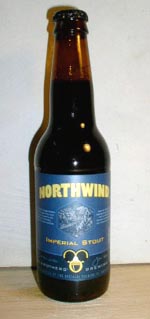 There was a time when the allure of the 22-oz “bomber” bottle was lost one me, perhaps owing to an almost religious commitment to avoiding trendy advocacies of any sort, but I must admit that after all these years, I’m beginning to see the attraction.
There was a time when the allure of the 22-oz “bomber” bottle was lost one me, perhaps owing to an almost religious commitment to avoiding trendy advocacies of any sort, but I must admit that after all these years, I’m beginning to see the attraction.Perhaps this owes to deeply repressed memories of backseat, paper-bagged quart bottles of beer brands I’d sooner not mention without the safety net of a certified shrink and his leather couch.
Something about a nice, big bottle filled with beer … but now, of course, the bottle’s strictly for pouring into a clean glass, not cradling directly to my lips, draining and tossing out the window at a passing street sign.
Not that I ever sanctioned that sort of activity, at least while sober.
Last night, returning home from a New Albany city council meeting and in need of a jar or two to keep me company while writing, I turned to a bomber of Two Brothers Northwind Imperial Stout.
Readers who know me well can attest to my predilection for Imperial Stout, the blackest beauty of all the strong ales, one packing a full deck of flavors into one glass while at the same time varying widely in strength (from low abv’s in the 7% range all the way to 11%, and sometimes beyond).
Viscosity always is high, and mouth-feel broad. Imperial Stouts can be intensely fruity, roasted, sweet and dry all in the course of a single serving.
I find the historical connections between Imperial Stout and its more elusive cousin, Baltic Porter, to be fascinating, and it has long been my opinion that there are more than a few cross-currents between these two styles and Bavaria’s beloved Doppelbock.
As a style that is innately strong, Imperial Stout has occupied a front-row seat in the market-driving field of extreme microbrews, with Rogue’s classic Russian Imperial Stout and Avery’s “The Czar” springing to mind during any discussion of the wonders of innovative excess. Both these are at the highest end of intensity and alcohol content.
The amazing and imported A. le Coq Double Imperial Stout deserves a posting of its own, as it incorporates history, intensity and gravity in a one delicious serving.
It’s worth remembering, though, that for many of us, Samuel Smith Imperial Stout served as our introduction to the genre, and it’s a relatively placid 7% abv. I drank a 12-oz SSIS recently, and enjoyed the textbook flavor, which manages to taste positively “light” compared with the Rogue and the Avery.
My last experience with Two Brothers Northwind Imperial Stout was during Gravity Head a couple of years ago, when our keg of Northwind, while drinkable, had a sour edge that didn’t really belong.
Consequently, I was wary when opening last night’s bomber, but happily, there were no flaws.
Northwind comes in at 8.5% abv, and in all significant respects it maintains this middle ground approach, drinking lighter than its alcohol, but having a pleasant mouthfeel and a powerful roastiness. The broad tableau of hints and nuances appropriate for the style is muted here, and yet the drinkability is high, and I must admit that it was a worthy accompaniment to tasks requiring thought and reasoning – the same sized bottle of “The Czar” would have wiped me clean long before the work was finished.
I’d rate Northwind as solid, and a good introduction to microbrewed Imperial Stout for those unfamiliar with the style.
Yes, it will be on sale at Rich O’s some time next week. How do you think I got the bottle for this review?
Oh, and rest easy -- the empty bottle went into the recycling bin after decanting.
Thursday, January 19, 2006
The Curmudgeon discusses his goals for the coming months -- nothing too personal, though.
Between now and the commencement of Gravity Head on February 24, I’m hoping to achieve a number of goals.
Among these are increasing my stocks of signature glassware, re-examining the bottled beer list (some beers come, and others go), and culling the cellar for beers suitable for vending come May and the annual FOSSILS Breweriana Sale.
These goals exist apart from what’s about to be required of the brewery, as in the case of an accurate system of accounting and invoicing for outside sales, incorporating our new logos and artwork into the marketing effort, and refining the core brands.
Gravity Head itself is a monster, requiring much attention to detail and a supreme effort at coordination in order to buy, store and tap 35-40 different beers over a month-long period.
Our banquet and meeting facility, which we’re calling Prost! after the German beer hall toast, is gradually rounding into shape. It will be available for scheduled events, parties, meetings and the like, and as with every other aspect of the business, there must be procedures and rules governing its use if we are to maximize the possibilities that such a space affords.
Nowadays, when I’m able to stay around at night and socialize a bit as in days of yore, it’s a kick. But if you’re wondering why I’m not hanging around during evenings as much as before … read the preceding again. It took a long time for me to get used to the idea that it’s a business and not just a living room with 33 taps … yet, for better or worse, that’s the way it is, now.
----
I’m tremendously excited about this year’s breweriana sale, which is tentatively scheduled for May 13. This is a Saturday, as opposed to previous years when the sale was held on Sunday owing to its size and having nowhere to put the vendors and still be open for business.
With Prost!, everything changes. We’ll open Rich O’s early on Saturday morning, have the usual menu (food and beer) available at all times, be able to house numerous breweriana vendors in Prost! – and have a very fun day all the way around.
For me, it means being able to hold one of my periodic ballast-reduction yard sales on the same day as the breweriana people are in attendance (remember, no carry-out sales on Sunday, so it couldn’t be done before).
Put this one on the calendar, and check for further details.
Wednesday, January 18, 2006
Ben woulda been proud.
Yesterday we dispensed somewhere between three and four kegs of Poor Richard’s “Old Lightning Rod” Ale to thirsty celebrants of Benjamin Franklin’s 300th birthday.
The New Albanian Brewing Company very much appreciates the great response. Special thanks to Dennis Stockslager, who brought a small keg of his homebrewed version to compare and contrast with the batch brewed by Jesse and Jared.
There was much clinking of glassware and animated discussions about Colonial life and times. Busy to work, but fun to be a part of.
Our friend and regular customer Dave has posted his review of PR's OLR here. Please feel free to add yours in the "comments" space below.
Tuesday, January 17, 2006
Happy Birthday, Benjamin Franklin.
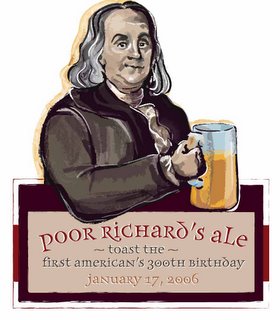 I should have no objection to go over the same life from its beginning to the end: requesting only the advantage authors have, of correcting in a second edition, the faults of the first.
I should have no objection to go over the same life from its beginning to the end: requesting only the advantage authors have, of correcting in a second edition, the faults of the first.-- Benjamin Franklin
Today is the 300th birthday of Benjamin Franklin, who was born in Boston on January 17, 1706.
At 11:00 a.m., Rich O’s Public House and Sportstime Pizza will be rolling out our barrels of Poor Richard’s “Old Lightning Rod” Ale. We brewed a full 8-barrel (248 gallon) batch, so it should be on tap for a while, not just today.
Revised and updated: Poor Richard's "Old Lightning Rod" Ale (NABC version) debuts on January 17, 2006.
We have the ale, but decided against pairing it with Colonial American food.
For more information in Benjamin Franklin, visit these and many other web sites:
The Benjamin Franklin Tercentenary
Exhibitions Review: Knowing a Man (Ben Franklin), but Not Melons, by Edward Rothstein (New York Times; December 19, 2005).
Benjamin Franklin: A Documentary History
Monday, January 16, 2006
Bourbon barrel stout aging at BBC Beer Company.
Last week, I mentioned a chat with Schlafly Beer’s (of St. Louis) Mitch Turner.
Mitch used to work for the now defunct Pipkin Brewing Company, which occupied the space at the corner of Main and Clay in downtown Louisville that now houses BBC Beer Company, production brewer of the familiar BBC brands, and a fine venue in which to drink them.
Beyond any doubt, the best beer Pipkin ever brewed during its brief three-or so-year run was Bourbon Barrel Stout.
At the time, probably six years ago, I became enthused over the possibilities afforded by a Kentucky brewery marrying craft beer with bourbon, and suggested that brewers and distiller could be partners in branding and marketing such a product, not just locally, but anywhere that bourbon enjoys prominence.
Consequently, my sense of personal vindication was very high this morning as I read this article in the Louisville Courier-Journal:
Bluegrass Brewing partners with distiller, by Bill Wolfe.
The significant part of this to me is the partnership between BBC Beer Company and McLain & Kyne Distillery, maker of Jefferson’s Reserve. Having the names of both companies on the label of “Bluegrass Brewing Co.'s Jefferson's Reserve Bourbon Barrel Stout” is the key to the cross-over between specialty beer and bourbon.
And, as a stunning bonus, we know the final product will be great because our friend David Pierce is the brewmaster running the show.
When we’ve done Bourbondaddy at NABC, my biggest regrets have been the lengthy process required to complete aging of the beer, the space taken by the barrels, and the necessity of maintaining a sane price point for draft sales – all this, and the entire batch would be gone in two weeks.
BBC Beer Company seems perfectly placed to minimize these disadvantages. The brewery has space (18 barrels filled for the first batch, as compared with three at a time at NABC), time and an efficient new bottling line -- and the price point for a premium, bottled beer can be much higher than draft.
I’m very excited, and will report back when I’ve had a chance to taste it.
Sunday, January 15, 2006
We address Friday nights at Rich O's, the smoking policy, and other concerns.
 The Curmudgeon (upper case “C”) is not about to rain indiscriminately on the parades of fellow curmudgeons (lower case “c”), all of whom know quite well what it’s like to feel, well, a tad curmudgeonly.
The Curmudgeon (upper case “C”) is not about to rain indiscriminately on the parades of fellow curmudgeons (lower case “c”), all of whom know quite well what it’s like to feel, well, a tad curmudgeonly.At the same time, as a business owner, I’m obliged (and in fact eager) to respond to the concerns and comments of our customers, who in turn are encouraged to provide their critiques and suggestions whenever the mood strikes.
Of course, I understand that such comments almost always are offered in a constructive manner, and as such, they are highly appreciated.
Thus, here are a few thoughts from a Rich O’s regular, as posted on his blog. Granted, I don't believe he was expecting a response, but because the issues raised are timely, I thought I would, anyway.
I don't think I like this new Rich O's very much. This new Rich O's where all of the assholes that used to stay out front, out of my way, are now suddenly compelled by the new smoking policy to come into Rich O's proper.
It's just so fucking crowded.
One of the PBDs remarked that the crowd was certainly good for the owners, and I have to agree that this is true. For now. But what happens when all of the regulars get so sick and tired of standing around all night waiting for a place to sit that they stop bothering to come in at all? What happens when they decide that it's not even worth checking to see what the crowd is like? What happens when they just go somewhere else?
I don't know the answers, and I don't have any solutions. I am pretty sure, however, that doubling the size of the place, but reserving that new space for port tastings and other "special" functions, when it's asses to elbows every single fucking Friday night - well that just doesn't seem like the most brilliant thing I've ever heard of.
Here are my thoughts in response.
The new smoking policy roughly doubled the perimeter of the previously delineated non-smoking section, and was undertaken owing to customer demand, especially insofar as larger groups are concerned.
Adding together the total seating capacity of Rich O’s and Sportstime Pizza, more than half of the seats still are smoking seats, and all the Sportstime seating area remains smoking friendly.
“Regular” customers are the lifeblood of any business, and it’s important to know that there are “regular” customers who have always congregated around the bar area (“Rich O’s proper”), but others who’ve sat and dined at tables in front, where smoking now has been eliminated.
To be truthful, demand for non-smoking seats from these regulars has consistently outpaced specific requests for seating where smoking is allowed.
There’s no doubt that henceforth, it will be more crowded in the bar area. At the same time, winter’s the busiest time in all respects, and in better weather, some customers will prefer to step outside and smoke. This coming spring, we hope to get started on a modest outdoor seating area. State law requires access to be from the Sportstime dining area, but in spite of this minor inconvenience, such a space could become a good draw in temperate weather and relieve the strain indoors.
As for Friday evenings in particular, ask any restaurant or pub owner in Louisville how well Mondays and Tuesdays do by comparison with Fridays, and try see how difficult it is to have consistent policies, procedures and service when seemingly every customer wants to come and eat right at 7:00 p.m. on Friday. It’s very, very hard to be efficient on Friday.
Our new banquet and conference area was not designed for overflow seating one night a week, because to use it that way would offer no help for the real problem we have, which is serving food. The kitchen’s simply not big enough to serve meals in a timely fashion to those extra people who would be seated in the new room – something that already is almost impossible on a Friday evening without seating there.
Pre-arranged functions can be operated according to a fixed menu and prepped beforehand.
Balancing the competing interests of smokers and non-smokers – and regulars and casual visitors – can be daunting, but we’re trying to forge a compromise and adjust conditions as we observe them.
By the way, as to a related point, I'm sorry we ran out of Weihenstephan and Baltika. They come from Cavalier in Indy, which delivers once every two weeks, and if we get a sudden run on product, there's no chance to order again for several days. Both beers should be back in stock by mid-week.
Saturday, January 14, 2006
The Curmudgeon does Oregon? Americana? Is anyone safe?
You can bet your last dime that the Curmudgeon intends to test this theory during his upcoming April visit.
In Oregon, It's a Brew Pub World, by Jessica Merrill (New York Times).
Good beer has become so commonplace that it has blended comfortably into the fabric of social life. Instead of fancy distractions, a big scene or a big screen, there is simply craft beer and a craft of another sort - the art of talking.
Yes, a road trip is being planned.
The Curmudgeon and Graham Phillips will be embarking on a nine-day highway outing to Portland, there to meet my wife, and Graham to visit with his son and family.
On the way, we’ll stop at Rogue Ales for an extensive sampling of that legendary brewery’s wares.
There may be other research possibilities in Northern California ...
From Portland, Diana and I will visit Seattle before flying back home.
Meanwhile, Graham will be spending extra quality time in Portland prior to returning to do whatever it is that retired people like him do when they’re not coming into Rich O’s for a pint.
But first, Gravity Head must be staged, and a few more miles put on aching knees.
Thursday, January 12, 2006
Stella Artois? I'll pass.
A Louisville Restaurant Forum reader asked: “Not a big fan of Belgian beers, Roger. But when a bartender recommended Stella Artois, I tried it found it to be a decent beer. Are my beer-snob credentials at risk?”
Here is an expanded answer.
----
You’re not at risk yet, but preventative education always is merited.
Just as a pound of ground chuck from Kroger somewhat vaguely hints at the many possibilities inherent in the concept of beef, so Stella Artois at least makes us aware of a country, Belgium, with so much more to offer in terms of the glories of beer.
By way of illustration, my favorite beer cafe in Brugge, ‘t Brugs Beertje, does not offer Belgium’s biggest selling beers -- Stella Artois, Jupiler, or Maes Pils -- because they’re pilsners, and as such, representative of a style that originated in the Czech lands and Germany. Quite simply, when it comes to Belgium's considerable native brewing heritage, pilsners aren’t a factor worthy of consideration.
Stella Artois is a gentle, soft, inexpensively brewed mass-market pilsner variant, and it is seen everywhere in Belgium, primarily because it is brewed and marketed by a monolithic corporation that has done every bit as much to bastardize that country’s brewing culture as Anheuser-Busch has in this one.
Admittedly, such largely flavorless lagers account for something like 70% of domestic sales in Belgium, where there are hundreds of traditionally conceived and craft brewed alternatives. In America, of course, the market share of industrial lager is even higher.
So, is Stella Artois a "bad" beer?
No, it probably isn’t, at least if we’re confined to discussing the beer itself and not the contemporary factors that have contributed to its lofty sales position. It's a mild, golden lager complete with alcohol, and competently rendered for the genre.
Is Stella Artois remotely indicative of the diverse Belgian brewing heritage?
No, emphatically, and yet that's how it is marketed within Belgium and around the world, with the sad result that many tourists come away with an extremely misshapen impression of what Belgian beer is all about, to return home to America and locally uninformed bartenders who recommend it on the basis of Belgian beer’s great reputation.
Conversely, there’s Duvel, an ale that truly reflects an important aspect of Belgium’s brewers: Their adaptability.
Duvel is made with pilsner malt and imported hops, and looks rather like a pilsner at first glance, but there’s more than meets the eye. It is top-fermented at a higher gravity, resulting in a clean, crisp and unique classic that isn't that far removed from what pilsner drinkers are accustomed to drinking, but adds Belgian ale-making flair to the finished product.
From the easy jumping-off point of Duvel, Belgian brewing expertise extends in all directions, and the further from Stella Artois one travels, the more absorbing and delightful it gets in terms of flavor profiles, textures, methods … and sheer enjoyment.
By the way, I’ve been told that draft Stella Artois has become available in the state of Indiana.
Don’t look for it at Rich O’s.
Wednesday, January 11, 2006
Draft Schlafly ales coming soon to Rich O's Public House.
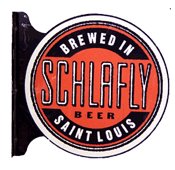 Yesterday I had the pleasure of chatting by phone with Mitch Turner, brand manager for Schlafly Beer in St. Louis.
Yesterday I had the pleasure of chatting by phone with Mitch Turner, brand manager for Schlafly Beer in St. Louis.Schlafly is the second largest brewery in the city – you get three guesses as to the identity of number one, and the first two guesses don’t count.
It has two distinct locations (three counting an airport outlet) and a solid, well-crafted core lineup of familiar microbrewed styles along with plenty of rotating seasonals to make things interesting for the regulars … and for the occasional out of town visitor.
In 2004, while in St. Louis for two inter-league games between the Oakland Athletics and the St. Louis Cardinals (both crushing defeats for my A's), the Baylors and the Tylers sought out Schlafly’s then spanking new Bottleworks in the city’s Maplewood neighborhood, which isn’t far away from the Hill’s famous Italian eateries.
Mitch gave us a great tour of the brewhouse, which was followed by a quality lunch and several rounds of rigorous, scientific sampling materials. I seem to recall Jay and I buying a case or two for home use. If so, my share didn;t last long.
I first met Mitch when he worked for Paul Hummer at Louisville’s defunct Pipkin Brewing Company (now the home of BBC Beer Company), circa 1998, perhaps a bit later. Somewhere in the archives there’s a candid pre-digital photo of Mitch on his hands and knees, hand-filling bottles of Pipkin Pale Ale, and no doubt plotting an early escape to greener pastures.
Based on our three-day visit, he certainly found them, both in his place of employment and his city of residence.
St. Louis is a vibrant big-league kind of place brimming over with art, entertainment, parks, architecture, and a microbrewery that has eluded the suffocating presence of the world’s largest manufacturer of carbonated urine to carve a considerable niche for itself.
In the summer of ’04, with Busch Stadium nearing the end of the line and a new park already under construction, the prevailing joke at Schlafly had to do with its tongue-in-cheek offer to purchase naming rights for the new park (alas, it too will be called Busch Stadium, A-B’s pockets being somewhat deeper than Schlafly’s).
The Schlafly Bottleworks was carefully planned to provide both a production facility and a complement to the brewery’s existing brewpub. An up-and-coming neighborhood was deemed appropriate, and a vacant supermarket property desired owing to the presence of loading docks and a spacious, adaptable floor plan.
The end result is a modern brewing, kegging and bottling operation, attached to a souvenir shop as big as the front room at Rich O’s, and restaurant/pub/banquet facilities with a food menu completely different from its sister brewpub.
Did I mention an outdoor seating area?
While the emphasis remains on the home market, Schlafly has started shipping small quantities of its beer to World Class Beverages in Indianapolis, and this was the topic my conversation with Mitch yesterday.
On the next Indiana-bound truck, there will be two kegs each of American Pale Ale/Expedition Reserve (Schlafly’s commemorative Lewis & Clark beer, now added to the list of regular brewery offerings) and Coffee Stout.
They’ll be on tap at Rich O’s as soon as they’re processed and delivered, and I’m imagining that Jay might want to come and have a taste of ale brewed in the epicenter of Cardinal Nation.
Surely I'll join him.
Tuesday, January 10, 2006
Poor Richard's "Old Lightning Rod" Ale in the C-J.
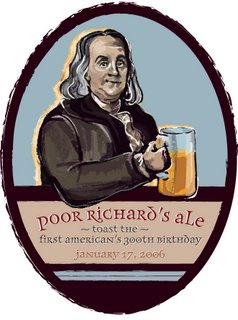 Read this nice piece in the morning newspaper:
Read this nice piece in the morning newspaper:Toast Ben's birth with a mug of Old Lightning Rod, by Susan Reigler (Louisville Courier-Journal).
In Indiana, the only other brewery (I think) that has brewed a Poor Richard's recipe is Lafayette Brewing Company.
Almost a keg was consumed during the special preview on Sunday night, with FOSSILS club members and a delegation from Destinations Booksellers provising good reviews. The best assessment I can offer is that PR's OLR has a dominant malt character, with ample evidence of its molasses and corn adjuncts, and perhaps a hint of oak. The flavor is familiar to modern palates, but different.
Monday, January 09, 2006
Ultra and Ultrabrune, from the Brasserie d'Ecaussinnes.
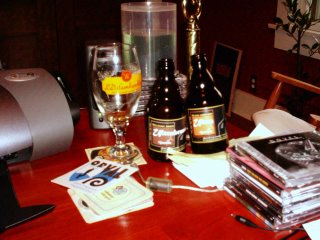 Later this week, I’ll be stocking two recently arrived Belgian ales: Ultra and Ultrabrune, both from the Brasserie d’Ecaussinnes.
Later this week, I’ll be stocking two recently arrived Belgian ales: Ultra and Ultrabrune, both from the Brasserie d’Ecaussinnes.Ecaussinnes d’Enghien is a village in northern Hainaut province, perhaps 30 KM northwest of Charleroi. This is Saison and farmhouse ale country, firmly French, with much to see and do.
Nearby Enghien is a larger town, one whose name you see reflected in the Silly brewery’s Double Enghien.
The d’Ecaussinnes brewpub is modern operation, only six years old, and it began with a kit salvaged from a defunct Czech plant. According to beer writer Tim Webb, 90% of its production is exported – a very high percentage even by the standards of Belgian craft brewing.
I’ve not been to visit this brewery, but the very thought of it causes me to daydream about bicycling through the Belgian countryside.
Actually, virtually anything conjures such daydreams.
If I were to do so and choose an Ecaussinnes product strictly for restorative purposes, the better choice would be Ultra, a fruity and very drinkable amber ale of 7% abv, and reputedly spiced, which might account for a light finishing bitterness that doesn’t taste like hops.
Later, under more contemplative circumstances, I’d opt for Ultrabrune (10% abv), a large and malty brown ale with an intriguing trace of Scotch caramelized malt flavor, a fine and full mouth feel, and a noteworthy impression overall.
Ah, beercycling. It doesn't get any better ... even when confined to the imagination.
They’ll be priced and available by Wednesday.
Sunday, January 08, 2006
You’ve been told wrong, Jack.
 Lebanon, Ohio (Associated Press) -- What’s a can of 24-year-old beer worth? What if the can was a tribute to the Cincinnati Bengals' first Super Bowl season?
Lebanon, Ohio (Associated Press) -- What’s a can of 24-year-old beer worth? What if the can was a tribute to the Cincinnati Bengals' first Super Bowl season?
The Bengals play Pittsburgh Sunday in their first playoff game in 15 years, and tickets are going for hundreds of dollars over face value. There's also a brisk market for clothing with Bengals logos, and all kinds of memorabilia.
Jack Chrisman of Lebanon, Ohio is willing to part with 150 cases of Hudepohl beer in cans he's been holding since that Cincinnati brewery issued them in 1981. They have Bengals stripes and “Hu-Dey” markings reminiscent of fans’ “Who Dey” cheer – “Who dey, Who dey, who dey think gonna’ beat dem Bengals?”
Chrisman, who had a business that served beer, sold 250 of the 400 cases he bought and stored the remaining 150 cases -- four six-packs of cans to a case -- in his garage.
“I’ve been walking around them in my garage for years,” Chrisman said. “I’ve got three stacks 10 feet high. I’d like to get rid of them.”
He figures now is the time and has placed classified ads asking $12.50 per 6-pack.
“They’re in really good condition, just like brand-new, and still full of beer,” said Chrisman, who paid $7 a case 25 years ago.
He just isn’t sure what beer with a born-on date of 1981 tastes like.
“I’ve been told the longer they sit, the better they get, Chrisman said.
Curmudgeon's note: The Bengals lost the game, a previous version of this story is here, and the photo credit goes to Melvin Grier of the Cincinnati Post newspaper.
Saturday, January 07, 2006
Bistro New Albany to open for business later this month at 148 E. Market Street in downtown New Albany.
On Thursday, I published this story at NA Confidential -- and the result was the second-highest hit count in NAC's 16-month history. As noted then, it's quite possible that I'm more thrilled about this than the people who are putting their money and sweat on the line to make it happen.
Finally – FINALLY – I can make good on my incessant hints, vague whispers and sly innuendo, and very happily provide NA Confidential’s readers with solid information pertaining to the extremely welcome news announced by this inconspicuous sign now posted in the window at 148 E. Market Street.
 Yes, it’s true. The Bistro New Albany, a completely new restaurant occupying the now defunct House of Bread floor space and patio, is well on its way to opening for business later this month, perhaps as early as January 16, but as I learned today, looking more like the 23rd.
Yes, it’s true. The Bistro New Albany, a completely new restaurant occupying the now defunct House of Bread floor space and patio, is well on its way to opening for business later this month, perhaps as early as January 16, but as I learned today, looking more like the 23rd.BNA is the brainchild of Greg Merz (front of the house) and David Clancy (chef), each of whom boasts more than two decades of work at all levels of the food and drink business.
They are understandably enthused about their new venture, and perhaps as importantly to many of us, they are excited about locating in downtown New Albany – not just because they can see the potential, but because, as Steve Earle says, the revolution starts now.
I met Dave for the first time today, but Greg's been coming around Rich O's for a while now. NABC's recent brewing expansion was undertaken at least in part to provide excess capacity that we could use to supply an outside draft beer account somewhere in downtown New Albany, and BNA's the one. Bluegrass Brewing Company (Louisville) will be supplying a couple of taps, and Greg will be rotating the others.
Following are comments written by Greg on a Louisville Restaurant Forum posting late last year. There may be a change here and there, but his description of the then-future project matches our chats in recent days.
1) The concept will be "bistro" style (even though that term has been done to death in American restaurants, it still describes best what we will do). The menu will be influenced by the finest the world -- not one individual cuisine -- has to offer. In starting, our menu will use core, i.e., French and Italian, but with New American touches, ingredients and styles, but we will not be beholden to them, and will indeed grow and expand as appropriate.
2) Food. The Chef has over 20 years in the business, was trained in California, and has considerable experience in Louisville. Again, his menu will attempt to bring interesting, solid (not "fly-by-night") trends from world cuisine to the table at our bistro. The emphasis will be in procuring all we can locally, be it food or beverage. Cheeses will be had from local producers (including, of course, Capriole Farms); coffee will be from a local home roaster; produce will be local whenever possible. Our menu will change every week (approximately 5-10% at the start, more as we gain experience. Reflecting the bistro concept, price points will be from $5-$10 at lunch, and $9-$25 at dinner.
3) Beverages. I am a certificate holder from the Court of Master Sommeliers, so the wine list will be good -- if not very good. Beer will be from excellent local craft brewers like New Albanian Brewing Company and Bluegrass Brewing Company, and will be served on draught in Imperial pints.
Greg told me today that the initial plan is for a six-day-a-week schedule for lunch and dinner, with the bistro closed on Sundays (but with the possibility of Sunday hours at some point in the future).
Here are some interior views of the forthcoming Bistro New Albany. These photos were taken last August, but other than a small bar area, nothing will be changing in the main room.
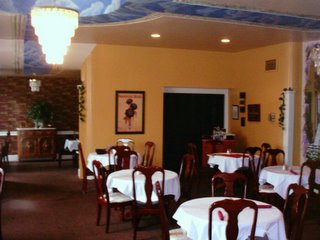
The nook toward the rear will be configured into a small bar and draft serving station. Greg's and Dave's license is for beer and wine -- no spirits.

The high-ceilinged front room facing market Street and the Little Chef diner is reminiscent of the bistro's past life as bar and restaurant in the New Albany Inn hotel.

Here are two exterior views, first looking west down Market Street, then north up Bank (with the Farmers' Market to the right, and Dave Thrasher's art store just ahead to the right in the Odd Fellows Building):


As will be seen during fair weather, the glory of BNA's location is the outdoor seating garden, accessed through a passageway off Bank Street. The doors lead into the Grand Convention Center.
 The outdoor garden is a classic European-style urban nook, and one of the nicest of its kind in the Louisville metro area. During Harvest Homecoming, Greg and I enjoyed an NABC Elector here while listening to live music. Now, instead of one weekend a year, the experience will be available any time the weather's favorable.
The outdoor garden is a classic European-style urban nook, and one of the nicest of its kind in the Louisville metro area. During Harvest Homecoming, Greg and I enjoyed an NABC Elector here while listening to live music. Now, instead of one weekend a year, the experience will be available any time the weather's favorable.

Neither of them will approve of my publishing this photograph, but here's a view of Greg (left) and real estate facilitator Mike Kopp (right) following the lease signing, which occurred at Rich O's late in 2005.
You'll be seeing more of Greg when you drink and dine at BNA. Mike likes to fly under the radar, but he is in the top echelon of people in the private sector who presently are making things happen downtown.
Keep reading for more details, and when the time comes, step up and show your support for local excellence. In the coming years, there'll be other unique, destination establishments opening in downtown New Albany as investors and entrepreneurs see the opportunities, and like Greg and Dave, build on the perseverence of today's downtown businessman. The best way to reclaim a share of what is rightfully ours lies not in the big-box excesses of the Clarksville exurb, but in the vision of individuality and quality embodied by these small businessmen with big ideas.
To hell with the pessimists - we're planning on having a sweet, sweet year.
Friday, January 06, 2006
Eateries, their choices in food, wine and beer, and lowest common denominators.
This topic stems from a conversation I had with Jim Huie at Maido on Christmas Eve, and was posted yesterday in slightly modified form at the Louisville Restaurant Forum, where a lively exchange ensued.
Jim remarked that when he and his wife were starting out, the local Anheuser-Busch representative was appalled when informed that there were no plans for Maido to sell Budweiser, spluttering somewhat ominously that they’d never stay in business with an attitude like that.
They still are … in business, and thankfully, remain imbued with such an attitude.
Indeed, for as long as I can remember, it has been accepted – and verging on the axiomatic – that a restaurant (not a bar, mind you) licensed to sell beer must offer at least the major mass-market brands: Bud, Bud Light, Miller Lite, Coors Light, perhaps MGD. Without these, or so the theory holds, disgruntled customers will refuse to patronize the establishment.
Being a contrarian by nature, I’ve conducted a decade-long search, and in spite of the menacing helpfulness of wholesaler reps like the one who spoke to Jim, there seems to be no “law” of any sort on the books that mandates this generally unquestioned “requirement” of being in the beer business.
Approaching this on a purely theoretical basis, is this notion really true?
(Full disclosure: Since the NABC brewery came on line in 2002, we have not served these brands at Sportstime Pizza or Rich O’s, our two pizzeria/pub faces to the public. Before that, we’d steadily reduced the number of such offerings in bottles at Sportstime, where the television sets are located, having completely ceased serving them at Rich O’s way back in 1994.)
Over the years, when asking this question of experienced, blood-and-guts restaurateurs and being told in response that there’s no conceivable way to avoid offering Bud and Bud Light, if for no other reason than as a service to clients like those I once observed at a top-notch Louisville steak house, carving away at a $30 prime rib entrée while chasing it with Lite consumed directly from the bottle, I’ve parried by asking whether the same logic would be applied to choosing the wine list.
Would Riunite or MD 20/20 be part of the wine list based on national sales figures alone, or is it possible to be more selective in offering better a wine and educating the consumer as to the differences?
Of course, the answer usually is, “well, that’s different.”
But is it really different?
If so, then why is it different?
Why shouldn’t the same considerations that lie behind the composition of the food menu and the wine list be applied to the beer list?
Note that I’m not suggesting that any restaurateur forego mild, golden lager beer – just that he or she considers beer in the same manner as other aspects of the operation when making the choices.
We consistently sell three or four kegs of Spaten’s perfectly serviceable Munich-brewed Helles (golden German-style lager) each and every week of the year, in addition to bottles of Samuel Adams, Heineken and the like (including Corona at $4.25 a bottle, just to see if people will pay such an outrageous price for bad beer).
Imagine the advent of a café with impeccably high standards of cuisine, upscale casual, excellent short wine list – in essence, nothing but the finest offerings and a target demographic to match.
Would such an establishment stock boxes of fridge wine according to the same resigned and unexamined logic used to justify stocking Budweiser?
If it were a vegetarian place, would it put an all-beef burger on the menu because so many people like that sort of thing and might not dine if it were not available?
Why must we accept the lowest common denominator in beer when we refuse to do so in wine and food?
Or must we?
Thursday, January 05, 2006
Three new NABC beer "labels," and more on the way.
One of our kitchen workers, Tony Beard, is an incredibly gifted artist.
As part of the NABC brewery expansion and overall product improvement project, we've engaged him to design new logos and produce official artwork for our house beers.
Here are three drafts, er, designs representing draughts. They're still subject to some revision, but they're so good, it's well worth a preview:
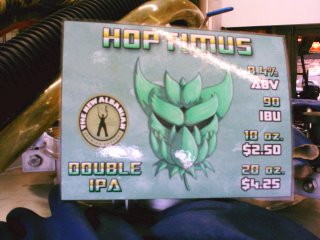
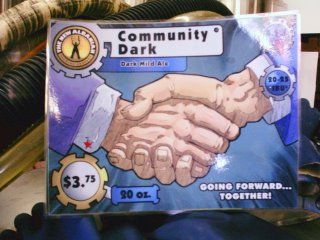
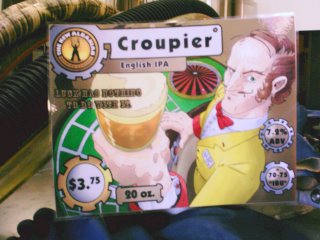 The Bob's Old 15 B has been done, too, but the image was unavailable for photographing. Yet to be executed is Elector, which will retain the "devilish" imagery of polling and unanimous choices.
The Bob's Old 15 B has been done, too, but the image was unavailable for photographing. Yet to be executed is Elector, which will retain the "devilish" imagery of polling and unanimous choices.I spoke with Tony today about designing the 2006 Gravity Head t-shirt, and he seems agreeable. We don't want to lose him, but as you can see, he's headed for bigger and better things.
Wednesday, January 04, 2006
Revised and updated: Poor Richard's "Old Lightning Rod" Ale (NABC version) debuts on January 17, 2006.
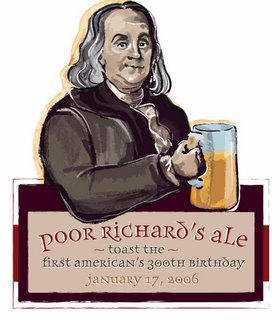 NABC will unveil its version of Poor Richard's "Old Lightning Rod" Ale on Tuesday, January 17. As of today, almost 100 breweries nationwide have chosen to participate in this celebration of Ben Franklin's 300th birthday by brewing a colonial-era recipe. It's a glimpse, albeit imperfect, into the flavor profile of the 18th-century.
NABC will unveil its version of Poor Richard's "Old Lightning Rod" Ale on Tuesday, January 17. As of today, almost 100 breweries nationwide have chosen to participate in this celebration of Ben Franklin's 300th birthday by brewing a colonial-era recipe. It's a glimpse, albeit imperfect, into the flavor profile of the 18th-century.
Members of the FOSSILS homebrewing and beer appreciation club will get a sneak preview of the ale on Sunday, January 8, as will the Serge Storms Historical Research & Debating Society, which will be meeting on the same night at Rich O's Public House.
Here's the updated story:
It wasn’t enough that Benjamin Franklin was a writer, inventor, businessman, statesman, patriot and all-purpose wit.
The creative Colonial-era legend somehow found time to drink beer, too.
In his writings, Franklin refers to the consumption of ale and describes various types of the fermented beverage, concluding that it was a healthy drink if consumed in moderation – an observation with which modern medical science concurs.
Even a teetotaler might be curious as to what these ales of old were like and how they were brewed, but unfortunately, substantive information is scant.
When the Benjamin Franklin Tercentenary, a non-profit group formed to organize the celebration for Franklin’s 300th birthday on January 17, 2006, began looking for an answer to this question, they found it by teaming with the Brewers Association, which commissioned a competition among professional brewers to formulate a Poor Richard’s Ale named for the famous Almanac.
Tony Simmons of Brick Oven Brewing produced the winning recipe, chosen by a panel of experts at the 2005 Great American Beer Festival. According to Simmons, his act of historical recreation was determined by the following factors:
Style ... Based on Franklin’s own writings, other period references and records of available raw materials, it is likely that he often drank tankards of a libation similar to Old Ale (England) or Strong Scotch Ale (Scotland).
Malt … “Low” (pale malt, similar to today’s Maris Otter or English floor malt) and “High” (darker malt, perhaps approximating a combination of what we now call Biscuit, Special Roast and Black) malts probably were used.
Adjuncts … During the Colonial era, imported malt was expensive and local barley crops were unpredictable, so the use of cracked maize and molasses in brewing was common.
Hops … Hop production in America did not begin in earnest until after Franklin’s passing, making it likely that traditional East Kent Goldings imported from England were the hops of choice.
Yeast … Not until the mid-19th century did modern scientific techniques unravel the mysteries of yeast, so it’s impossible to know very much about 18th-century yeast management. Simmons suggests that contemporary English or Scottish strains of yeast (low to moderate attenuation) will suffice to replicate Colonial fermentations.
The Brewers Association asked member breweries nationwide to join in the celebration of Benjamin Franklin’s 300th birthday by brewing a special batch of Poor Richard’s Ale and having it ready for serving on January 17, 2006.
The New Albanian Brewing Company's brewers, Jesse Williams and Jared Williamson, followed the broad contours of Simmons's recipe, adding a few touches of their own like extra finishing hops and oak chips to add wooden barrel-conditioned character. They also suggested an alternative name, "Old Lightning Rod," which we've duly incorporated to identify the finished product.
The finished product is malty and on the sweet side, both expected owing to low hopping and the use of molasses and corn as sources of fermentable sugars. We detect vanilla and banana notes alongside the unmistakable molasses component.
Several of our homebrewing friends and patrons from FOSSILS and LAGERS are said to have used the recipe parameters provided by Tony Simmons and brewed their own batches of Poor Richard’s Ale.
If you're one of them, bring your homebrewed version on the 17th, and we'll sample alongside our NABC commercial version to celebrate Benjamin Franklin’s 300th birthday.
Tuesday, January 03, 2006
A spotlight on DeuS Brut des Flandres, but too late for New Year's Eve.
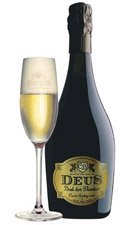 DeuS Brut des Flandres, which is brewed in Belgium by Bosteels, was the 2003 “Malt Advocate” Import Beer of the Year, and has occupied a well-deserved spot on the Rich O’s beer list since 2004, courtesy of Mat and the guys at Cavalier in Indianapolis.
DeuS Brut des Flandres, which is brewed in Belgium by Bosteels, was the 2003 “Malt Advocate” Import Beer of the Year, and has occupied a well-deserved spot on the Rich O’s beer list since 2004, courtesy of Mat and the guys at Cavalier in Indianapolis.While not the sort of ale one would seek after mowing the lawn, it provides a rare and elegant dimension to special occasions.
The first "sparkling ale" of this type that I ever tasted was Malheur Biere Brut, which Daisy offered to my 2002 Belgian tour group as part of our special “beer academy” tasting in the back room of ‘t Brugs Beertje in Brugge.
The process and effect are much the same as DeuS, as described in this passage by Artisanal Imports:
DeuS is brewed with the finest summer barley and select hops, but unlike any other Belgian specialty, it undergoes a lengthy, costly maturation in the Champagne region of France. For centuries, the French have used the elegant and labor-intensive “methode Champenoise” as the way to make the best sparkling wines in the world. DeuS receives this treatment, just as the finest Champagne, and the result is remarkable.
Following the initial fermentation, DeuS is shipped to France, where practitioners of “methode Champenoise” follow their strict protocol of bottle turning (“remuage”) and yeast removal (“degorgement”). The entire process takes more than a year, but it’s well worth the wait.
DeuS is clearly not a sparkling wine, nor is it a “beer” in the traditional sense. With flavors of anise, fresh malt, herbal hops and a slightly bready yeast note, it truly combines "The Best of Two Worlds." Serve DeuS ice cold in a narrow flute or champagne goblet for best appearance and flavor.
The Times of London has taken notice, as evidenced by this article from December, 2005, by John Elliott and Steven Swinford: A £32 bottle of beer with your meal madam?
IT LOOKS like champagne and costs just as much. But the latest vintage bubbly coming to Britain’s restaurant tables is a £32 bottle of beer.
Deus, brewed in the Belgian village of Buggenhout, is matured in the Champagne region of France. Its corked bottle is the same shape used for Dom Perignon champagne.
In spite of the obvious shock value of the beer’s price, the writers manage to provide a nicely balanced treatment of the beer and the concept – at least until they seek the opinion of a wine writer on staff:
Joanna Simon, the Sunday Times wine critic, said: “It’s a very good beer. But no matter how it’s dressed up — and, boy, it is dressed up — it’s still only beer.
“The palate is creamy-smooth, fruity and malty-sweet, and the finish is clean with characteristic beer bitterness. But it’s short and that’s the problem. Why pay good money for a taste that disappears in a couple of seconds? I’d rather have half a bottle of good champagne.”
Funny, but I’ve always felt the same way about wine (“it’s short”), especially when trying to find an example of one (any) that would accompany Bavarian pork knuckle and the fixings as well as Doppelbock does, or Thai curry like a ball-buster of an IPA can.
(Thanks to Jay and Bill for pointing the Curmudgeon this way ... photo credit goes to Artisanal)
Monday, January 02, 2006
No comment. None needed.
You'll not be seeing that photo here. If it's real.
I'm not denying it.
Sunday, January 01, 2006
Will Goose Island hop into bed with A-B?
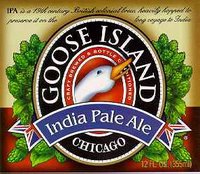 Goose Island may partner with maker of Budweiser, by Ameet Sachdev (Chicago Tribune staff reporter; Published December 21, 2005 … thanks to Jay Tyler for the link).
Goose Island may partner with maker of Budweiser, by Ameet Sachdev (Chicago Tribune staff reporter; Published December 21, 2005 … thanks to Jay Tyler for the link).Change may be brewing at Goose Island Beer Co.
The beer industry has been buzzing for weeks about talks between Chicago's largest microbrewery and Anheuser-Busch Cos., fostering speculation the St. Louis beer giant may be interested in buying an ownership stake in Goose Island.
Several readers have asked for the Curmudgeon’s opinion on this news item, no doubt seeking to prod me into unleashing one of my trademark anti-Budweiser screeds.
For now, I refuse to bite.
Well, perhaps a nibble.
It remains true that any company with a 50% combined market share and a long history of predatory behavior cannot be trusted to adhere to any stated aim of benign partnership with a company so much smaller than itself, but we already knew that, didn’t we?
If Goose Island, a perfectly respectable microbrewery with high standards of quality, albeit one that no longer is “cutting edge,” decides to don its trunks and hop into the pool for a dog paddle with the sharks, that’s its business – and a decision that may profoundly alter its business.
Anyone remember Celis? Didn’t think so.
At the same time, a market’s a market, and perhaps a deal with the devil is the one that brings an equitable return for Goose Island’s owners. If you own a business, you’ll probably agree with me that it always is for sale. Everyone actually does have a price. It may be so high that there's little chance of anyone ever paying it, but it's there, just the same.
At least lovers of good beer – the type of beer that Anheuser-Busch generally eschews – have many more options than before when it comes to avoiding the leaden monopoly of the nation’s largest producer of carbonated urine.
Like I said … no rants out of me.
Stylistically, Goose Island steers a safe, entry-level path, but they’ll always have a place in my heart, as the original Goose Island brewpub in Chicago was the first such American establishment I ever had the pleasure of visiting (in 1992).
Personally, I hope they don’t make a mistake by dancing with the 800-pound gorilla.
If they do, and it ends badly at the hands of the bean counters, at least we have numerous insurance policies, i.e., microbreweries, to fall back on.
